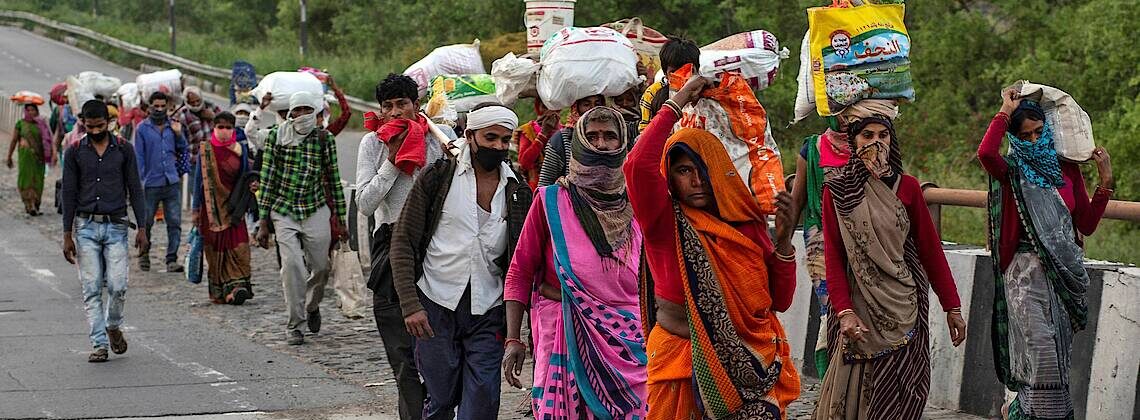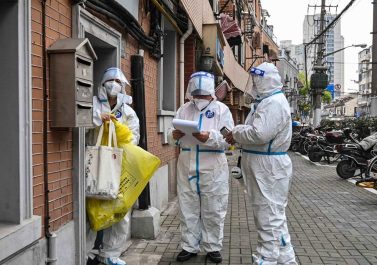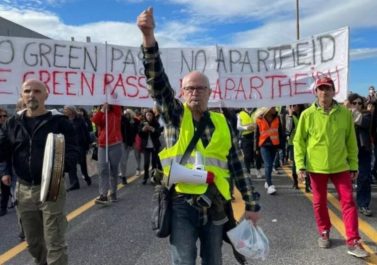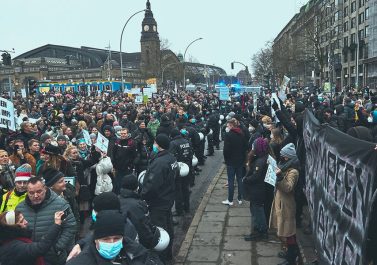In early-April we wrote a political summary of some of the global working class struggles under the Covid-19 regime. [1] We want to reiterate that ultimately it will depend on these struggles as to whether the current crisis will result in deeper divisions within the global working class or lead towards unification.
Still, we can analyse some of the material boundaries and confinements that these struggle take place within, set by the peculiarities of national markets, the specific sectorial conditions or state interventions. Here we see a difference between divisions as outcomes of ‘market movements’ and those resulting from targeted state policies. Our main question is: where do divisions deepen and where are they weakened?
We deliberately keep this summary short and schematic, in order to facilitate further discussions. We see it as part of our collaboration in the internationalist website: www.feverstruggle.net
1) Technocratic control over the core sectors and periphery
The way the modern state and industry dealt with the Covid-19 crisis is based on their technocratic collaboration and financial power. Permanent workers in the automobile industry, e.g. in Germany and France were given relatively high paid short-time work [2], and Porsche and VW in Germany paid each worker around 8,000 to 10,000 Euro annual bonus during the peak time of the lockdown. This maintains the already existing division between the core staff and workers on temp-contracts or in the car component supply industry. The German government announced an increase to the general payment for workers on ‘short-time work’, and workers on these higher wages are now benefitting even more from the increase because of tax regulations. The retention of workers in the automobile industry is not just a divide and rule tactic. The internal structure of the industry relies on the reproduction of a fairly skilled workforce, which cannot be treated as seasonal or replaceable labour. Here we see sectorial divisions between workers in e.g. complex manufacturing on one side and restaurants, retail and tourism on the other. It is also questionable that employment in the core industry can be seen as a privilege, given the fact that it’s tied to a technocratic paternalism based on the combined control of management and unions over the workers. So after an agreement between VW management and the union, IG Metall, 63,000 workers at the main plant in Wolfsburg returned to work on the 27th of April 2020 – endangering their health. [3] Furthermore, the position of the export-oriented German car industry and the workforce within it has to be seen in an international context. In the current dispute between the German government and the crisis-ridden EU states, such as Italy, Greece and Spain, the German government defends the interest of the local industry in a stable and devalued Euro against the need of the southern EU states for looser purse strings. Workers in the core sectors in Germany compare their situation and so do workers down south, e.g.the Nissan workers near Barcelona who just went on strike against the threat of permanent plant closure will know how their condition compares with their German counterparts. [4] This is the material context for the ‘anti-German’ propaganda of the political class in Italy, which resonates within the local working class. The ‘German model’ of state control over the core sectors and the international periphery also expresses itself in the mass recruitment, containment, isolation and administration of thousands of seasonal workers from Romania, who are employed in German agriculture.
2) Division between manual and intellectual workers
Due to the peculiar nature of this (health) crisis the division between manual and intellectual workers is, initially at least, deepened by the fact that many ‘intellectual’ workers might be able to work from home, while many manual workers cannot. This division is further deepened by the general difference in income levels and subsequent inequality when it comes to (crowded) housing conditions or medical provisions depending on where you live. This can be expressed in very stark and superficial terms, as done by The Economist for the situation in the USA: “A recent survey found that workers earning more than $70,000 per year can perform more than 60% of their work tasks from home; for those making less than $40,000, the figure is less than 40%.” [5] This picture becomes slightly more complex once we see that in many regions these differences are also overlayered in terms of ‘native’ and ‘migrant’ workers, as more migrant workers will be employed in lower paid manual work, or in terms of racist divisions within the class. Here working class areas in inner-city USA or the banlieus in France share a similar fate. We can also see that the forms of control and coercion over manual workers differs from those exercised over intellectual workers. Essential workers in the US meat industry, previously perhaps hailed as heroes by the public, are now facing the threat of direct state coercion in the form of the Defense Production Act which would force them back to work.Workers in some plants have reacted with wildcat walkouts. [6] The pressure on workers is compounded by the enormous concentration process in the industry, e.g. the meat processing factory of Tyson Foods in Paco supplies meat for four million people a day. State intervention also targets health workers, e.g. after 19 patients died of COVID-19 at a nursing home in Pennsylvania and nurses went on strike to protest unsafe conditions, the Democratic Governor Tom Wolfe sent the National Guard to man the facility. This was a threat that could be applied to other facilities where nurses are striking. [7] Most ‘intellectual’ or office workers might face less direct forms of coercion, but we can see the proliferation of technological changes to tighten control over their remote labour, e.g. the Italian state uses the crisis to accelerate the digitalisation of public sector administration work [8] and workers in education and tele-services have to deal with an increase in tele-work from home (although we know about generally lower productivity rates). Recently we have seen Amazon tech workers stop work for the day in solidarity with sacked warehouse workers around the world. In the overall political situation, the concrete material differences between ‘intellectual and manual’ workers can become less significant and the common struggle the determinant factor. [9]
3) Labour market control and citizenship
Another major state intervention when it comes to the control over largely manual labour is enforced through the migration regime. In most cases this re-shapes divisions amongst workers according to their citizenship status – although in the cases of internal migration in China and India we can see that the state’s brutal treatment of migrants is not primarily a question of nationalism, but of the containment of labour. [10] When it comes to international migration we can see the way the state in Germany, Italy and UK find ways to deal with labour shortages, particularly in agriculture. Short-term contracts and social isolation are also justified as bio-political measures for public health. In other parts of the world labour migration has more significance for the local economy and class composition, such as in the United Arabic Emirates, who have recently been hit by the decline in oil prices. Kerala, which is currently presented by the left as the role-model ‘communist’ state when it comes to Covid-19 treatment depends entirely on remittances from 2.1 million ‘Keralan’ workers in the Gulf Countries. Thus, the local health system cannot be detached from the bombs on Yemen. In the Emirates the economy depends on migrants to such a degree that mass deportations are out of the question. Therefore the state forces companies to house and pay for laid-off workers for the time being, but it is a question of time before a more sophisticated divide-and-rule policy will set in in order to adjust the labour supply to decreased demand. Recent migrant workers’ actions of across the globe – from Mexico to Poland – show that these measures won’t go uncontested. In the border area of Germany and Poland hundreds of workers who live in Poland and work in Germany protested against the quarantine measures of the Polish state, which enforces two weeks quarantine after each visit in Germany. [11] Migrant workers confronted the police in Calais (France) when the cops hassled them. [12] and in Moria and Chios (Greece). [13]
4) The situation in the ‘informal economy’
Workers in the ‘informal sector’ who have neither access to company benefits or (sufficient) state welfare are hit hardest by the economic crisis. The ILO speaks about 1.6 billion out of work worldwide. Two billion proletarians in the informal sector will lose large shares of their income. They calculate that during the first month of the crisis the income of workers in the informal sector in Africa and the Americas has contracted by 81%. [14] Here we see a deepening material inequality within the class both regionally – as the informal sector is more dominant in regions such as Africa and Latin America – and locally, as other workers might have access to company provisions or unemployment money. In India, for example, most construction workers are not registered as ‘workers’ and therefore have problems accessing state benefits. [15]
It is therefore likely that the struggle of public sector workers against the privatisation and ‘informalisation’ of the enterprises they work for will intensify, as workers know that access to state benefits are often tied to the public sector job. Recent strikes against mine privatisation in Iran are an example of this. [16] The state also uses the situation to attack the informal housing of the local working class.There has been an increase in slum demolitions from Pakistan to South Africa to Haiti. [17] Some of the fiercest clashes with the police are related to the informal status of the proletarians involved, from sex workers [18] to market women [19] to local youth who riot in Senegal after the police killed a young proletarian during the curfew. [20] The political problem here is that the situation creates a ‘common interest’ between poor proletarians, who need to go to work or peddle their goods, and the petty bourgeoisie, who are desperate to keep their small businesses afloat.
5) Division between working class and ‘petty/lumpen bourgeoisie’
We have to understand the class composition and political trajectory of the recent ‘anti-lock-down’ protests of the far-right in the US and other states – and what they have in common, or not, with the protests of proletarians in the aforementioned informal sector. In the US – and perhaps in Brazil, as well – it seems that the Covid-19 crisis breaks the electoral alliance of the far-right government consisting of marginalised ‘blue collar workers’ and the petty bourgeoisie. [21] The business interests of the petty bourgeoisie is in tune with their ‘libertarian anti-communist protest’. While ideologically many Trump-voting ‘blue collar workers’ might support a libertarian position against the federal state and the legal lockdown, they also realise that as ‘front-line’ or industrial workers they are the main victims of the Covid-19 pandemic. Facing a similar situation in Brazil it doesn’t seem unlikely that Bolsonaro’s recent announcement to pay a kind of universal basic income is an attempt to paper over the cracks that appear in this alliance.
6) Differences for workers in big and small enterprises
The tendency of an acute divergence of interests between blue-collar workers and petty bourgeoisie during the pandemic laid out above is counteracted by the impact of the economic crisis on small enterprises – and the workers they employ. Research shows that up to a million UK firms will run out of cash within the next four weeks putting around 4 million people out of a job. [22] The threat of similar small business insolvencies is being felt in the US. Despite government loan schemes, it seems that banks are still making it hard for small business owners to access them. [23] This is a considerable lobby which will try to mobilise ‘their employees’ politically. With the very real possibility of a decimation of this more petty bourgeois layer is the parallel trend of bigger companies like Amazon getting even bigger, soaking up the excess labour now flooding the job market. The class implications of this are worth considering in terms of various factors such as: size of workplaces and workforces that pose a political risk for companies and new opportunities for workers
7) Division between home-owning and renting working class
This might be a UK particularity where the political integration of the working class was and is so bound to the question of home ownership. As during the aftermath of the 2008 financial crisis the state made sure to signal to the home-owning segment of the class that they will get a ‘mortgage-holiday’ if required, whereas tenants were not given such protection. Even the Labour Party recently watered down their ‘opposition’ for their demand for renters’ protection. Their policy has now changed from rent suspension to rent deferment. [24] Rent strikes as a response are widely publicised but seem to be either based on previously existing structures or limited to bigger landlords and associations.
8) Aggravating crisis of the working class family
The increased financial strain and the peculiar nature of the crisis sharpen the divisions inside working class families. Elderly care homes as mass detention of largely poorer family members become death traps. The internal division of labour when it comes to childcare, which in many cases depends on grandparents is threatened by the requirements of the lockdown and preventive measures. In Italy calls to domestic violence helplines increased by 75% during the peak of the pandemic. [25] At the same time this crisis and the fact that wider ‘mutual aid’ is necessary in order to sustain the reproduction of working class family life might lead to the appreciation of more (neighbourly) collectivity even beyond the times of acute pandemic.
9) An increase in sectoral differences and subsequent changes in the hierarchies of the international state system
Regions and national economies that rely on specific export goods or income from single economic activities, such as tourism [26], are hardest hit by the current slump. Whether is it the copper mining industry in Zambia or the garment industry in Bangladesh [27] the survival of millions of workers are directly or indirectly attached to these hegemonic national industries. This export dependency is often mirrored in monetary terms as a dependency on the US Dollar or other ‘global currency’ incomes, e.g. in order to pay for food imports. Here the crash of oil prices caused a slump in purchasing power of millions of global proletarians and a sovereign debt crisis forNigeria, Iraq, Ecuador and Venezuela – countries that had calculated their national budgets and debt payments at $50 a barrel and now see their income halved. [28] At the same time five of the world’s largest grain exporters have restricted exports since the beginning of the Covid-19 crisis. [29] These conditions are already resulting in mass revolts from Iraq [30] to Somalia [31] to Colombia. [32] These conditions of a limited local industrial and agricultural base impose limits on these movements, as long as they remain isolated nationally, in terms of their abilities to go beyond demands for less corruption and better food subsidies. At the same time the international dimension of these protests might be able to overcome national structural limitations – in particular if, and this is not unlikely, giants like the Russian central state will become increasingly shaky. [33]
10) Divisions based on previous struggle experiences
States have reacted differently to lockdown measures in regions that witnessed ‘popular’ or working class movements before the Covid-19 crisis kicked in. The fact that more workers go on strike and more kids revolt against the police in France than in the UK or Germany is less due to differences in the immediate material conditions, and more to do with previous struggles. In most regions that saw protests before the crisis, such as in Haiti [34], Panama [35] or Chile [36] struggles picked up again after the virus broke out. In Lebanon the crisis has aggravated the financial situation at a debt ratio of 170% to GDP and this time round the protests have lost their trust not only into the political class, but also in the army. [37] Strikes which have picked up again in the Maquiladoras in Mexico this time hit the supply-chain of the US car industry at a time when workers in the US themselves are questioning managements’ command. [38]
11) The current left is a hindrance in our efforts to understand the divisions and develop a working class strategy
The reaction of the left regarding this complex picture is confined within the usual parameters of reformist opportunism or ultra-left voluntarism.The statist left sees state spending as a confirmation of ‘left policies’ and not as crisis management of a capitalist state that cannot be detached from its repressive function. They don’t tend to see the ability of the US or UK state to ‘throw money at the problem’ as intimately tied to the deadly debt crisis of other states. Most importantly, they think that the various divisions within the working class can be overcome by general demands, rather than by a perilous and complex process of unification through struggle. The ultra-left reaction ignores the challenge material differences pose for the process of unification and celebrate each singular struggle as if by becoming ‘more radical’ it would contain the solution.
Overall we think that the social and material power of the state to enforce a ‘divide and rule’ tactic is weakened by the crisis. However, this does not mean that the working class is automatically strengthened to overcome internal divisions. In the current moment we can see that the ‘immediate interests’, the specific demands, divide the working class as much as they unify. To appeal to the working class to unite, purely on the basis that ‘we have a common enemy’ won’t go far. Revolutionary strategy has to analyse the diverging material conditions of struggles in detail and contrast the differences with the only material basis for working class unification: the take-over of the means of production requires a globally concerted effort.The fact that workers will have to unite for this effort is not primarily due to common interests, but due to the fact that the global productive apparatus cannot be taken-over piecemeal. The basis for solidarity is our global material interdependence. This is the basis of a communist program, not based on history or ideals, but as a program of measures. [39]
Footnotes:
[1] https://angryworkersworld.wordpress.com/2020/04/15/global-struggles-against-the-covid-19-regime-early-april/
[2] In France the unions and PSA management agreed on 100% wage payments, that is 30% more than the legal minimum paid to 9 million workers on official short-time work, while around 2.5 million workers don’t even get that, due to irregular employment.
[3] https://www.wsws.org/de/articles/2020/04/27/vwwb-a27.html
[4] https://twitter.com/ridersxderechos/status/1253044233084305410?s=20
[5] https://www.economist.com/graphic-detail/2020/04/24/many-poor-americans-cant-afford-to-isolate-themselves
[6] https://www.theguardian.com/us-news/2020/apr/28/trump-executive-order-meat-processing-plants-coronavirus
[7] https://paydayreport.com/defying-trumps-order-nebraska-meatpackers-strike-pa-national-guard-replaces-striking-nurses-richmond-threatens-to-fire-striking-nurses/
[8] https://publicservices.international/resources/news/lockdown-pushes-digitalisation-through-in-italian-public-services?id=10735&lang=en
[9] https://www.vice.com/en_us/article/n7jaaq/amazon-reinstates-fired-warehouse-worker-after-employees-strike
Seemingly small news, but the sacking of two Amazon tech-workers is another example of alienated 'tech and science workers' who take the right side in the class war. For scientific communism from below! https://t.co/KTq4CKweEi
— AngryWorkers (@WorkersAngry) April 15, 2020
[10] https://www.newindianexpress.com/nation/2020/apr/28/the-jean-dreze-interview-keeping-migrant-workers-from-returning-home-will-deepen-covid-19-financial–2136066.html
[11] https://twitter.com/WorkersAngry/status/1254461372328443904?s=20
[12] https://twitter.com/WorkersAngry/status/1253346541483556867?s=20
[13] https://twitter.com/revsoc21/status/1253290307627683840?s=20
Fire and clashes with riot police at VIAL #refugeesGr hotspot now in #Chios island according to local media. #Greece https://t.co/fxL8iMm7gu
— Savvas Karmaniolas (@savvaskarma) April 18, 2020
[14] https://www.ilo.org/berlin/presseinformationen/WCMS_743038/lang–de/index.htm
[15] https://www.newslaundry.com/2020/04/23/covid-19-relief-how-india-doesnt-count-the-poor-as-workers
[16] https://twitter.com/IranNW/status/1252223745852182528?s=20
[17] https://www.opendemocracy.net/en/beyond-trafficking-and-slavery/we-are-still-waiting-protesting-under-lockdown-in-south-africa/ https://twitter.com/WorkersAngry/status/1250698923968212992?s=20
[18] https://twitter.com/InvisiblesMuros/status/1255216977406242817?s=20
[19] https://twitter.com/HaitiInfoProj/status/1253390689032790016?s=20
[20] ]https://berthoalain.com/2020/04/20/coronavirus-couvre-feu-affrontements-a-batanko-kedougou-15-avril-2020/
[21] https://jacobinmag.com/2020/04/coronavirus-pandemic-lockdown-protests-ubi
[22] https://www.independent.co.uk/news/business/news/coronavirus-small-businesses-collapse-bust-research-a9440771.html
[23] https://www.bbc.co.uk/news/business-52043896
[24] http://www.gmhousingaction.com/labour-covid19-renters/
[25] https://twitter.com/WorkersAngry/status/1252608069965660161?s=20
[26] https://nuevocurso.org/turismo-cero/
[27] https://in.reuters.com/article/health-coronavirus-bangladesh-protests/bangladesh-textile-workers-flout-coronavirus-lockdown-to-demand-wages-idINKCN2280EM
— AngryWorkers (@WorkersAngry) April 18, 2020
[28] https://www.foreignaffairs.com/articles/2020-04-02/emerging-market-petrostates-are-about-melt-down
[29] https://www.zeit.de/2020/18/lebensmittelversorgung-landwirtschaft-nahrungsmittel-hungerkrisen-coronavirus-pandemie?wt_zmc=sm.ext.zonaudev.twitter.ref.zeitde.share.link.x
[30] https://rampantmag.com/2020/04/16/iraqs-tahrir-finishing-what-we-started/
Anti-government and corruption protests in Iraq yesterday. Attempt to storm the town hall. Police use life ammunition- six people are injured https://t.co/MRaRvK95aM
— AngryWorkers (@WorkersAngry) April 27, 2020
[31] https://twitter.com/th1an1/status/1254159912839581705?s=20
[32] https://twitter.com/WorkersAngry/status/1250782699620569088?s=20
[33] https://twitter.com/WorkersAngry/status/1255398726962733059?s=20
[34] https://twitter.com/madanboukman/status/1254916000061014019?s=20 https://twitter.com/madanboukman/status/1254916000061014019?s=20
[35] https://twitter.com/madanboukman/status/1254916000061014019?s=20
[36] https://twitter.com/WorkersAngry/status/1255143574452056071?s=20
[37] https://twitter.com/prolewave/status/1255139065076125697?s=20
[38] http://wildcat-www.de/en/current/e_a116_mexico.html
https://www.ft.com/content/ed4307a6-a061-4772-881a-6c07be377a03?list=intlhomepage
https://eu.elpasotimes.com/story/news/2020/04/23/coronavirus-juarez-factory-workers-electrical-components-international-strike-covid-19/5165842002/
[39] https://angryworkersworld.wordpress.com/2020/04/07/revolutionary-working-class-strategy-for-the-21st-century-part-1/



